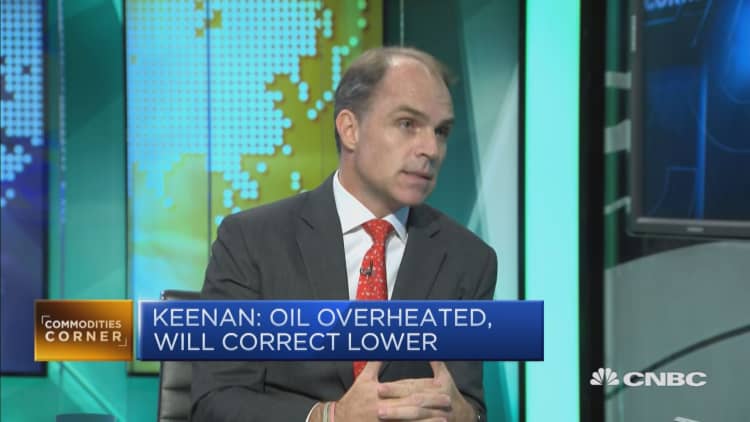Oil prices fell on Monday, pressured by a strengthening dollar and rising U.S. crude output, but prices remained on track for a big monthly gain.
U.S. West Texas Intermediate (WTI) crude futures finished Monday's session down 58 cents, or nearly 1 percent, at $65.43 a barrel, while Brent crude futures were down $1.21, or 1.7 percent, at $69.31 a barrel by 2:23 p.m. ET.
So far this month, the Brent crude price has risen by 3.6 percent, while WTI is up 8.5 percent.
Weighing on WTI prices, analysts expected U.S. crude supplies would post a weekly rise for the first time in 10 weeks, a preliminary Reuters poll showed on Monday. Industry group American Petroleum Institute posts its data on Tuesday and the U.S. Energy Information Administration reports on Wednesday.
"Drawdowns in Cushing, Oklahoma have really been a lever point for trade in recent weeks and months. That will be watched very closely," said Anthony Headrick, energy market analyst at CHS Hedging LLC in St. Paul, Minnesota.

Oil prices have been buoyed by the U.S. dollar's six straight weekly slides. The greenback is set to fall 3 percent this month. Oil is priced in the U.S. currency, so a falling dollar can boost demand for crude from buyers using other currencies.
The dollar index had been below $90 since Jan. 24. But the currency has rebounded nearly 0.5 percent since Friday to $89.59, which has weighed on crude prices.
"After six weeks of losses balance is inevitable. Its influence has really resurged as of late to where the dollar index below $90 has propped up oil," said John Kilduff, partner at Again Capital LLC in New York.
Crude prices also had drawn support from a large premium in the front-month Brent oil contract over those for future delivery, as investment in crude futures and options reached a new record high last week.
"The market is bullish. One side that could correct significantly could come from the strength in the U.S. dollar," PVM Oil Associates strategist Tamas Varga said.
Oil consumption is surging as a result of growth in major economies, while OPEC and its allies have made repeated commitments to limiting their crude output.
On Monday, Iraq's oil minister said in London that the oil market was improving, and that the country would comply with OPEC output cuts even though it is trying to increase its oil export capacity.

Somewhat offsetting the OPEC-led cuts has been rising oil output in North America.
"We believe that todays oil prices project a too rosy picture," said Julius Baer's head of macro and commodity research Norbert Ruecker.
U.S. output has jumped more than 17 percent since mid-2016. It is expected to exceed 10 million bpd soon.
U.S. production is now on par with top exporter and OPEC kingpin Saudi Arabia. Only Russia produces more
U.S. bank JP Morgan said it had increased its 2018 average price forecast by $10 per barrel to $70 per barrel for Brent and by $10.70 per barrel for WTI to $65.63.
"We expect Brent to touch close to $78 per barrel towards end of Q1 2018 or early Q2 2018," it added.
— CNBC's Tom DiChristopher contributed to this report.

